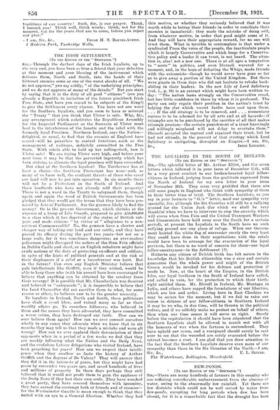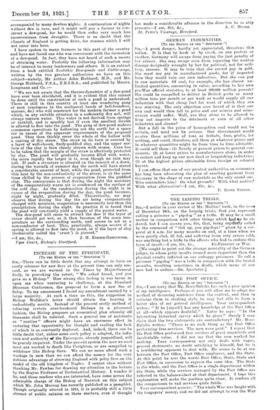DEW-PONDS.
.• [TO THE EDITOR OF THE " SPECTATOR."3 SIH,—There are many hundreds of farmers in this country who are suffering considerable embarrassment from the absence of water, owing to the abnormally low rainfall. Yet there are few districts which could not be well served by water from dew-ponds, excepting for long periods when dew has been absent, for it is a remarkable fact that the drought has been
accompanied by many dewless nights. A continuation of nights without dew is rare, and it might well pay a farmer to con- struct a dew-pond, for he would then suffer very much less inconvenience from droughts. There is no doubt that the climate of England is getting drier, for reasons which I will not enter into here.
I have spoken to many farmers in this part of the country and have not found one who was conversant with the formation of a dew-pond. In fact, they have not heard of such a means of obtaining water. Probably the following information may be of interest to many landowners and others. It is an extract from a book entitled Neolithic Dew-ponds and Cattle-ways. written by the two greatest authorities we have on this subject—namely, Mr Arthur John Hubbard, M.D., and Mr. George Hubbard, F.S.A., F.R.I.B.A., and published by Messrs. Longmans and Co.:- " We are not aware that the thermo-dynamics of a dew-pond have ever been elucidated, and it is evident that this cannot be done until the construction of such a pond is understood. There is still in this country at least one wandering gang of men (analogous to the- mediaeval bands of bell-founders, masons, &c.) who will construct for the modern farmer a pond which, in any suitable situation in a sufficiently dry soil, will always contain water. This water is not derived from springs or rainfall, and is speedily lost if even the smallest rivulet is allowed to flow into the pond. The gang of dew-pond makers commence operations by hollowing out the earth for a space far in excess of the apparent requirements of the proposed pond. They then thickly cover the whole of the hollow with a coating of dry straw. The straw in its turn is covered by a layer of well-chosen, finely-puddled clay, and the upper sur- face of the clay is then closely strewn with stones. Care has to be taken that the margin of the straw is effectively protected by clay. The pond will gradually become filled with water, the more rapidly the larger it is, even though no rain may fall. If such a structure is situated on the summit of a down, during the warmth of summer day the earth will have stored a considerable amount of heat, while the pond, protected from this heat by the non-conductivity of the straw, is at the same time chilled by the process of evaporation from the puddled clay. The consequence is that during the night the moisture of the comparatively warm air is condensed on the surface of the cold clay. As the condensation during the night is in excess of the evaporation during the day, the pond becomes, night by night, gradually filled. Theoretically, we may observe that during the day the air being comparatively charged with moisture, evaporation is necessarily less than the precipitation during the night. In practice it is found that the pond will constantly yield a supply of the purest water. The dew-pond will cease to attract the dew if the layer of straw should get wet, as it then becomes of the same tem- perature as the surrounding earth, and ceases to act as a non-conductor of heat. This, practically, always occurs if a spring is allowed to flow into tho pond, or if the layer of clay (technically called the ' crust ') is pierced."
Tryse Court, Bishop's Stortford.



































 Previous page
Previous page